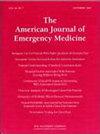The impact of the 2024 intravenous fluid shortage on emergency department length of stay and 72-hour return rate
IF 2.7
3区 医学
Q1 EMERGENCY MEDICINE
引用次数: 0
Abstract
Introduction
In September 2024, there was an abrupt intravenous (IV) fluid shortage in the United States due to the unexpected closure of a major production facility. In response, hospitals rationed scarce IV fluids. While this was aimed at reducing utilization, the impact on patient care is unclear. This study assesses the impact of reduced IV fluid ordering on emergency department (ED) operational metrics.
Methods
Retrospective cohort study at an urban academic medical center ED with 55,000 annual encounters. All patients seen during the pre-shortage (7/1/24–9/30/24) and post-shortage (10/1/24–11/13/24) periods were included. We assessed differences between proportions of patients receiving IV fluid, volume of fluids, length of stay (LOS), and 72-h return rate. We also assessed a subgroup of discharged patients with gastrointestinal illness. Comparisons used a Wilcoxon ranked-sum, Chi-squared or Fisher's exact test as appropriate. Logistic regression was performed with controls for age, gender, and emergency severity index (ESI).
Results
IV fluids were given in a smaller proportion of patients (20 % vs 24 %, p < 0.001) and at lower volumes post-shortage. Discharged patients with gastrointestinal symptoms likewise had lower IV fluid use (30 % vs 42 %, p < 0.001), decreased LOS (7.1 vs 7.8 h, p < 0.001) and no change in 72-h return rate (p = 0.156).
Discussion
During the 2024 IV fluid shortage, fewer patients received fluids at lower volumes per patient. This held true for discharged patients with GI symptoms. Overall, LOS decreased without an increase in 72-h return rate. Improved throughput without changes in return rate represents a potential process improvement and warrants further evaluation.
2024年静脉输液短缺对急诊科住院时间及72小时复诊率的影响
2024年9月,由于一家主要生产设施意外关闭,美国突然出现静脉注射(IV)液短缺。作为应对措施,医院配给了稀缺的静脉注射液。虽然这是为了减少利用率,但对病人护理的影响尚不清楚。本研究评估减少静脉输液订购对急诊科(ED)操作指标的影响。方法回顾性队列研究在一个城市学术医疗中心ED每年55,000次就诊。所有在短缺前(7/1/24-9/30/24)和短缺后(10/1/24-11/13/24)期间就诊的患者均被纳入。我们评估了接受静脉输液的患者比例、液量、住院时间(LOS)和72小时复发率之间的差异。我们还评估了一组患有胃肠道疾病的出院患者。比较时适当使用Wilcoxon秩和、卡方或Fisher精确检验。以年龄、性别和紧急情况严重程度指数(ESI)为对照进行Logistic回归。结果给予静脉输液的患者比例较小(20% vs 24%, p <;0.001),短缺后的销量较低。有胃肠道症状的出院患者同样有较低的静脉输液使用量(30% vs 42%, p <;0.001), LOS降低(7.1 vs 7.8 h, p <;0.001), 72小时回报率无变化(p = 0.156)。在2024年静脉输液短缺期间,更少的患者接受了更低容量的液体。对于有胃肠道症状的出院患者也是如此。总体而言,LOS降低,但72h报酬率没有增加。在没有退货率变化的情况下提高吞吐量代表了潜在的流程改进,值得进一步评估。
本文章由计算机程序翻译,如有差异,请以英文原文为准。
求助全文
约1分钟内获得全文
求助全文
来源期刊
CiteScore
6.00
自引率
5.60%
发文量
730
审稿时长
42 days
期刊介绍:
A distinctive blend of practicality and scholarliness makes the American Journal of Emergency Medicine a key source for information on emergency medical care. Covering all activities concerned with emergency medicine, it is the journal to turn to for information to help increase the ability to understand, recognize and treat emergency conditions. Issues contain clinical articles, case reports, review articles, editorials, international notes, book reviews and more.

 求助内容:
求助内容: 应助结果提醒方式:
应助结果提醒方式:


